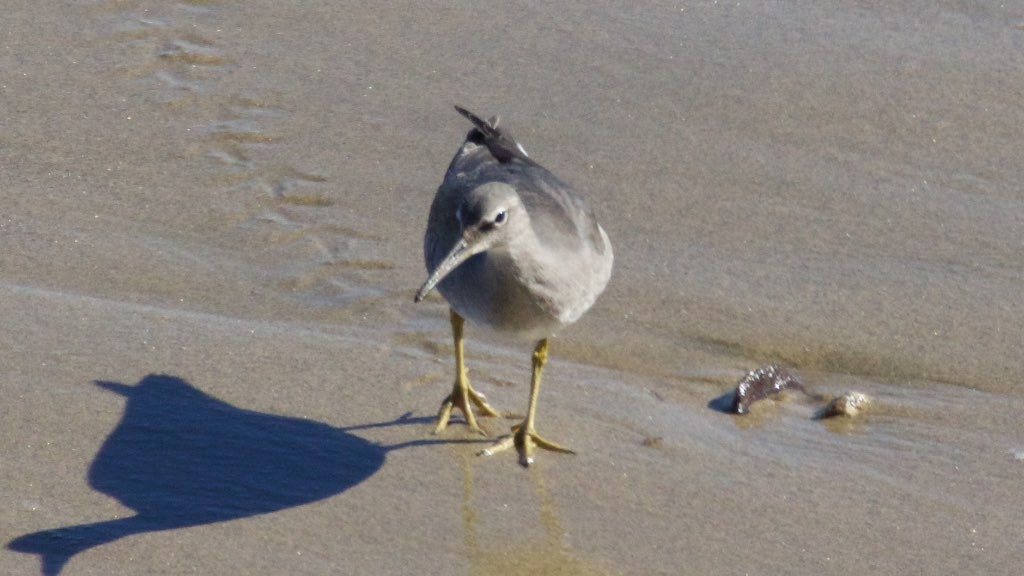Wandering Tattler
A species of Tringa Scientific name : Tringa incana Genus : Tringa
Wandering Tattler, A species of Tringa
Botanical name: Tringa incana
Genus: Tringa
Content
Description General Info
Description
The wandering tattler (Tringa incana) (formerly Heteroscelus incanus: Pereira & Baker, 2005; Banks et al., 2006), is a medium-sized wading bird. It is similar in appearance to the closely related gray-tailed tattler, T. brevipes. The tattlers are unique among the species of Tringa for having unpatterned, greyish wings and backs, and a scaly breast pattern extending more or less onto the belly in breeding plumage, in which both also have a rather prominent supercilium. These birds have stocky bodies with gray upperparts, underwings, face and neck and a white belly. They have short dark yellow legs and a dark gray bill. Adults in breeding plumage are heavily barred underneath. In summer, they are found in far-eastern Russia, Alaska, portions of the California coast and northwestern Canada. They nest in rocky areas along mountain streams. At other times, they are found on rocky islands in the southwest Pacific and on rocky Pacific coasts from California to South America and as far as Australia. They feed on aquatic invertebrates such as crustaceans and marine worms. During breeding season, they also eat insects. While wading, they forage actively, making jerky bobbing movements. Feeding behaviors can include repeated returns to the same location over short periods of time. They can be seen flying low over a rocky coastline or along a jetty. The female lays 4 olive-colored eggs in a shallow depression. Both parents incubate and help feed the young, who are soon able to forage for themselves. The call is a rapid trill of accelerating, descending notes of decreasing volume. 
Size
28 cm (11 in)
Nest Placement
Ground
Feeding Habits
Wandering Tattler predominantly consume insects and various invertebrates from both freshwater and marine habitats. They actively engage in visual hunting by walking along shores and probing under objects. Wandering Tattler adapts to environmental conditions, sourcing food by flipping over foliage, wading into water to submerge their head, or catching flying insects mid-air. Wandering Tattler is versatile in their diet, including stoneflies, crustaceans, mollusks, and on occasion, plants such as algae.
Habitat
Wandering Tattler typically inhabits rugged landscapes with an inclination towards montane tundra intersected by rivers and streams. These terrains feature a mix of ponds, lakes, and rocky fields, often surrounded by tall shrubs and complex waterways. The bird favors stony upland tundra adjacent to moist sedge meadows, nesting up to altitudes of about 4,000 feet. Coastal lowlands with gravel beds also serve as nesting grounds. For foraging, wandering Tattler utilizes riverbanks and lakeshores, while nesting sites are chosen in drier areas, amidst dwarf shrubs, mountain avens, and lichens.
Nest Behavior
Wandering Tattler builds ground nests near mountain streams, lays eggs in a lined depression, and both parents partake in caring for the progeny.
Nest Characteristics
The nest of wandering Tattler is a ground depression amid pebbles, scree, boulders, or stunted vegetation by tundra streams. Twigs, leaves, and lichens line the 5.1-inch-wide nest with a 3.7-inch-wide, 2-inch-deep cup.
Dite type
Aquatic invertebrate eater
General Info
Feeding Habits
Bird food type
Behavior
Wandering Tattler showcase a highly active lifestyle, punctuated by intricate courtship displays, which are particularly noticeable during breeding season. Their daily activities involve foraging in coastal areas, with agile movements along rocky shorelines in search of food. Wandering Tattler are known for their distinct flight patterns, involving a variety of maneuvers such as trembling wingbeats, glides, and dives. Interaction with their habitat also includes frequent call exchanges, signaling their presence to potential mates. Wandering Tattler typically avoid conflict, emphasizing their unique behavioral tendency to focus on elaborate mating rituals rather than territorial disputes.
Species Status
Not globally threatened.
Scientific Classification
Phylum
Chordates Class
Birds Order
Shorebirds Family
Sandpipers Genus
Tringa Species
Wandering Tattler 